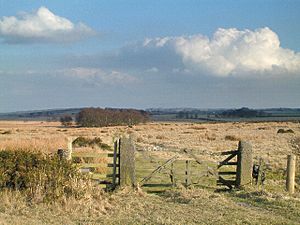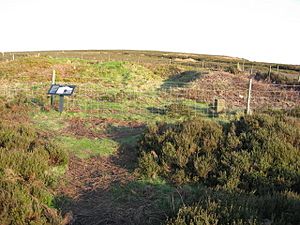Beeley Moor facts for kids
Beeley Moor is a beautiful, open area in the Peak District of central England. It's a high, rocky place made of a type of stone called gritstone. You can find it close to the villages of Beeley and Baslow. The highest point on Beeley Moor is about 371 meters (1,217 feet) above sea level. It's a great spot for exploring nature and learning about history!
Contents
Exploring Beeley Moor's Landscape
Beeley Moor is part of a larger moorland area called East Moor. This includes other places like Gibbet Moor. To the northwest, you'll find the famous Chatsworth Estate.
Rivers and Streams
Two important streams start on Beeley Moor. The River Hipper begins its journey here at a spot called Hipper Sick. Another stream, Beeley Brook, also flows from the moor. As it runs down towards Beeley village, you can see several pretty waterfalls.
A Look into Beeley Moor's Past
Beeley Moor is a very old place, filled with history from thousands of years ago. It's known as a "prehistoric landscape." This means people lived here long before written records. You can find many ancient sites that are now protected. These include old stone piles called cairns, burial mounds, and special stones that might have marked paths.
Hob Hurst's House
One very special ancient site is called Hob Hurst's House. It's an unusual square burial mound from the Bronze Age. This was a time about 4,000 years ago when people used bronze tools. Hob Hurst's House is located on Harland Edge, between Gibbet Moor and Beeley Moor.
In 1853, a person named Thomas Bateman dug into this mound. He found a stone box, called a cist, inside. This box held the ashes of someone who had been cremated. Since 1882, Hob Hurst's House has been a protected national monument. Local stories say the site was named after a friendly goblin who supposedly lived there!
Old Industries and Buildings
About 300 years ago, people mined coal on Beeley Moor. This coal was used to melt lead and to heat local homes. The high-quality gritstone found on the moor was also very useful. It was quarried (dug out) and used to build the grand Chatsworth House. In the past, Beeley Moor was also a popular place for hunting birds like grouse.
Visiting Beeley Moor Today
Today, Beeley Moor is "Open Access" land. This means the public is allowed to walk and explore freely across most of the moor. This became possible thanks to a law passed in 2000 called the Countryside and Rights of Way Act. You can reach the moor from Beeley Village by following footpaths that go through Beeley Plantation. It's a great place for a hike and to enjoy the outdoors!



